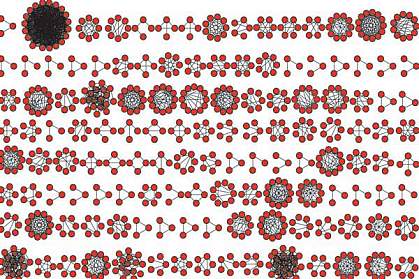You are here
September 21, 2015
The Interactome: Mapping Protein Interactions
At a Glance
- Researchers created a draft map of over 1 million protein interactions—an “interactome”—across more than 100 animal species, including people.
- Understanding such interactions will improve our understanding of how the human body works and what can go wrong to cause disease.

Genomics is the study of an organism’s complete set of DNA, including all of its genes. Researchers have identified more than 20,000 human genes that code for proteins, the body’s building blocks. The study of the body’s proteins and their functions, proteomics, is even more complex. Each gene doesn’t simply code for one protein; stretches of DNA can be read and translated into proteins in different ways. Proteins also interact to form functional complexes that can be tricky to study.
A team of researchers led by Dr. Edward Marcotte from the University of Texas at Austin and Dr. Andrew Emili from the University of Toronto set out to produce a comprehensive map of protein complexes across a range of animal (metazoan) species. By looking at these complexes across diverse species, the scientists hoped to gain insights into human biology, development, and evolution. They selected 8 other species whose genomes had been sequenced. The species—worms, flies, mice, sea urchins, frogs, sea anemones, amoebae, yeast, along with humans—span roughly a billion years of evolution. The scientists also examined multiple cell types and developmental stages across species.
To isolate intact protein complexes, the team used a technique called biochemical fractionation. They then used quantitative mass spectrometry to examine the protein components of the complexes. The study, funded in part by NIH’s National Institute of General Medical Sciences (NIGMS), was published in Nature on September 17, 2015.
The team detected and verified more than 16,600 protein interactions in humans. Because most of the interactions were conserved across species, the team was able to extend their findings and predict interactions among proteins for more than 122 species with sequenced genomes. Using this approach, they predicted over 1 million protein interactions.
The team used these predicted interactions to group the proteins in functional complexes. They identified almost 1,000 complexes. Many are ancient ones that preceded animal life and have played core roles in cell function for at least a billion years. Other complexes are unique to multicellular organisms, helping to hold cells together, guide their fates, or determine their organization.
In an example of how this approach may give insight into human disease, the team found an unexpected role in frog head and eye development for a protein complex dubbed Commander. One of its protein components was recently tied to intellectual disability and other development problems in people.
“Essentially, we were able to construct a sort of assembly diagram of how thousands of different proteins come together to carry out their proper roles inside the cells of most kinds of animals,” Marcotte says. “Protein assemblies in humans were often identical to those in other species. This not only reinforces what we already know about our common evolutionary ancestry, it also has practical implications, providing the ability to study the genetic basis for a wide variety of diseases and how they present in different species.”
—by Harrison Wein, Ph.D.
Related Links
References: Panorama of ancient metazoan macromolecular complexes. Wan C, Borgeson B, Phanse S, Tu F, Drew K, Clark G, Xiong X, Kagan O, Kwan J, Bezginov A, Chessman K, Pal S, Cromar G, Papoulas O, Ni Z, Boutz DR, Stoilova S, Havugimana PC, Guo X, Malty RH, Sarov M, Greenblatt J, Babu M, Derry WB, R Tillier E, Wallingford JB, Parkinson J, Marcotte EM, Emili A. Nature. Sep 17;525(7569):339-44. doi: 10.1038/nature14877. Epub 2015 Sep 7. PMID: 26344197.
Funding: NIH’s National Institute of General Medical Sciences (NIGMS); National Science Foundation; Canadian Institutes of Health Research; Natural Sciences and Engineering Research Council of Canada; Cancer Prevention and Research Institute of Texas; Ontario Research Fund; and Welch Foundation.
